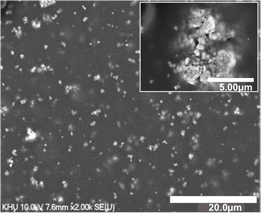Feb 13 2015
A team of researchers from South Korea has developed a thin multiferroric film that would soon enable devices to become more bendable and at the same time retain its electrical and magnetic properties despite it being curved.
 This electron microscope image shows tiny nanoparticles of bismuth ferrite embedded in a polymer film. The film enhances the unique electric and magnetic properties of bismuth ferrite and preserves these properties even when bent. (IMAGE CREDIT -- YoungPak Lee/ Hanyang University)
This electron microscope image shows tiny nanoparticles of bismuth ferrite embedded in a polymer film. The film enhances the unique electric and magnetic properties of bismuth ferrite and preserves these properties even when bent. (IMAGE CREDIT -- YoungPak Lee/ Hanyang University)
This research may lead to applications in wearable devices. The new thin film is illustrated by researchers in a paper published in the journal Applied Physics Letters, from AIP Publishing.
Although electronic devices have become comparatively smaller in size since the 1950s, they still remain rigid, not allowing users the freedom to wrap their phone around their wrist while jogging or to fold their computer to fit in a pocket. Manufacturers struggle to create flexible electronics as many materials with key electronic properties are typically stiff. To solve this rigidity issue, researchers used microscopic fragments of materials, such as silicon, and embedded them into bendable plastics.
A South Korean group of physicists and engineers tried this approach with bismuth ferrite (BiFeO3). The essential aspect of BiFeO3 is that it is possible to control its electrical properties using a magnetic field and vice versa. These materials are referred to as multiferroics and tend to be used in applications such as instant-on, energy-efficient computing.
The research team produced bismuth ferrite nanoparticles and incorporated them into a polymer solution. Then the solution was dried step by step by increasing the temperature, to create a thin, bendy film. The new film’s electric and magnetic properties were tested. It was noticed that their new material not only retained the properties of bulk bismuth ferrite but also improved them. The improved quality of the material continued to remain even when it was bent and formed into cylindrical shapes.
Bulk bismuth ferrite has crucial problems for some applications, such as a high leakage current which hinders the strong electric properties.
Mixing nanoparticles of bismuth ferrite into a polymer improved the current-leakage problem and also gave the film flexible, stretchable properties.
Flexible multiferrorics could enable new wearable devices such as health monitoring equipment or virtual reality attire. The multiferroric materials could be used in high-density, energy efficient memory and switches in such devices.
YoungPak Lee - Professor
Hanyang University, Seoul, South Korea
However, before the new films are commercialized for use in wearable technology, the researchers are keen to further work on its multiferroic properties, and also spend time exploring other even more flexible materials.